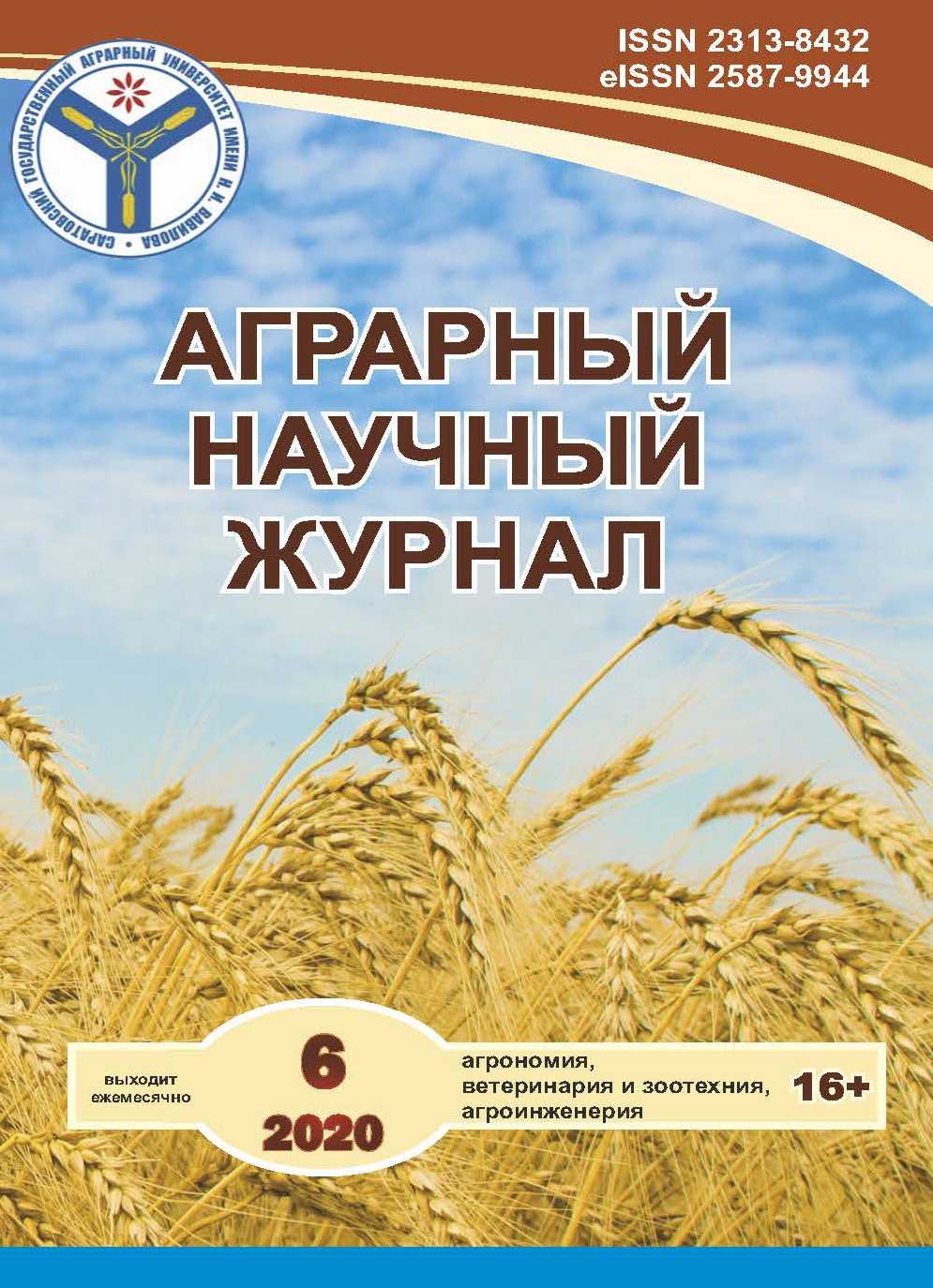Cluster analysis of economically valuable traits of maize hybrids in the conditions of the Saratov Right Bank
DOI:
https://doi.org/10.28983/asj.y2020i6pp14-20Keywords:
maize, productivity, plant height, interphase periods, number of grains, cluster, Euclidean distanceAbstract
The results of a study of 42 maize hybrids of various ecological and geographical origin by a complex of economically valuable traits in the conditions of the Saratov Right Bank are presented. In order to optimize the breeding process, we used cluster analysis, which allows one to group a large array of hybrids into several groups (classes) that differ in a complex of parameters. As a result of clusterization at the 34th step of iteration, maize hybrids are grouped into 8 clusters according to the main economically valuable traits. It was revealed that the composition of the clusters differs by years of research. The same reaction similarity to environmental conditions was revealed in hybrids: Ross 140 SV and RNIISK 1; Ladozhskiy 292 MV and Ladozhskiy 298 MV; Agata and Dokuchaevsky 190; as well as hybrids Bilyar, Mashuk 171 MV, Mashuk 175 MV, and Baikal. The correct distribution of hybrids across clusters is confirmed by analysis of variance (unorganized repetition). It was established that according to all the studied signs, the differences in the clusters are significant.
Downloads
References
2. Доспехов Б.А. Методика полевого опыта (с основами статистической обработки ре-зультатов исследований). – 5-е изд., доп. и перераб. – М.: Агропромиздат, 1985. – 351 с.
3. Иванова Е.В., Андроник Е.Л., М.Е. Маслинская Применение многомерного анализы при оценки сортообразцов льна масличного в контрольном питомнике // Земледелие и селекция в Беларуси. – 2014. – №5. – С. 446–456.
4. Кривошеев Г.Я., Шевченко Н.А., Ионова Е.В. Критерии оценки засухоустойчивости са-моопыленных линий кукурузы // Аграрный вестник Урала. – 2014. – № 11 (129). – С. 6–12.
5. Кукуруза в Сибири, (монография) / Н.И. Кашеваров [и др.]. – Новосибирск, 2004. – С. 66–69.
5. Маратынов С.П.Кластерный анализ саратовских сортов яровой пшеницы по коэффи-циентам родства // Цитология и генетика. – 1989. – №4. – С. 37–43.
6. Методика государственного сортоиспытания сельскохозяйственных культур. Зерно-вые, крупяные, зернобобовые, кукуруза и кормовые культуры. – М., 1989. – Вып. 2. – 200 с.
7. Перфильев В.Е., Лебедев А.В., Григорьева А.Ф. Оценка степени сходства или различия между сортами по комплексу количественных признаков: метод. рекомендации по при-менению статистических методов в генетике и селекции плодовых культур (под ред. Перфильева В.Е.). – Мичуринск, 1980. – С. 101–110.
8. Супрунов А.И., Чилашвили И.М., Анашенков С.С. Оценка нового исходного материала для селекции среднеспелых и среднепоздних гибридов кукурузы // Кукуруза и сорго. – 2013. – №4. – С. 24–29.
9. Сотченко В.С. Перспективы возделывания кукурузы для производства высокоэнерге-тических кормов. Селекция, семеноводство, технология возделывания кукурузы. – Пя-тигорск, 2009. – С. 18–20.
10. Супрунов А.И., Чилашвили И.М., Попов С.С. Оценка нового исходного материала для селекции средних и позднеспелых гибридов кукурузы // Проблемы и тенденции инно-вационного развития агропромышленного комплекса и аграрного образования России: материалы Междунар. науч.-практ. конф. – пос. Персиановский, 2012 . – С. 167–171.
11. Хаджинов М.И. Селекция кукурузы // Кукуруза. – 1958. – № 1. – С. 34–39.
12. Чилашвили И.М. Оценка новых самоопыленных линий для селекции среднеспелых гибридов кукурузы в условиях центральной зоны Краснодарского края: дис. … канд. с.-х. наук. – Краснодар, 2016. – 152 с.
13. Чеботарь С.В., Сиволап Ю.В. Дифференциация, идентификация и создание базы дан-ных сортов T. Aesmivum L. украинской селекции на основе STMS–анализа // Цитология и генетика – 2001. – № 6. – С. 18–27.
14. Югенхеймер, Р.У. Кукуруза: улучшение сортов, производство семян, использование. – М.: Колос, 1979. – 519 с.
15. Bertolini, M., Brandolini G.V., Lorenzoni C. Selezione ricorrente in una varieta sintetica di mays (Zea mays L.) a base genetic stretta //Riv. Agron. 1989. Vol. 23. No. 3. P. 249–254.
16. Coors J.G. Twelve cycles of mass selection for prolificacy in maize. Direct and correlate re-sponses // Crop Sci. 1989. Vol. 29. No. 2. P. 262–266.
17. Duvic D.N. Genetic contribution to advance in yield of U.S. maize // Mayadica. 1992. Vol. 37. No. 1. P. 69–80.
18. EdvardS J.W., Lamkey K. R. Quantitative genetics of inbreeding in a synthetic maize popu-lation // Crop Sci. 2002. Vol. 42. No. 4. P. 109–110.
19. Helme T.C., Hallauer A.R., Smit O.S. Genetic drift and selection evaluated from recurrent selection programs in maize / Crop Sci. 1989. Vol. 29. No. 4. P. 602–607.
20. Yau S.K., Ortis–Ferrara G., Srivastava J.P. Claster analysis of bread wheat lines grow in di-verse rain fed environment // RACHIS. 1989–8. 2. P. 31–35.








